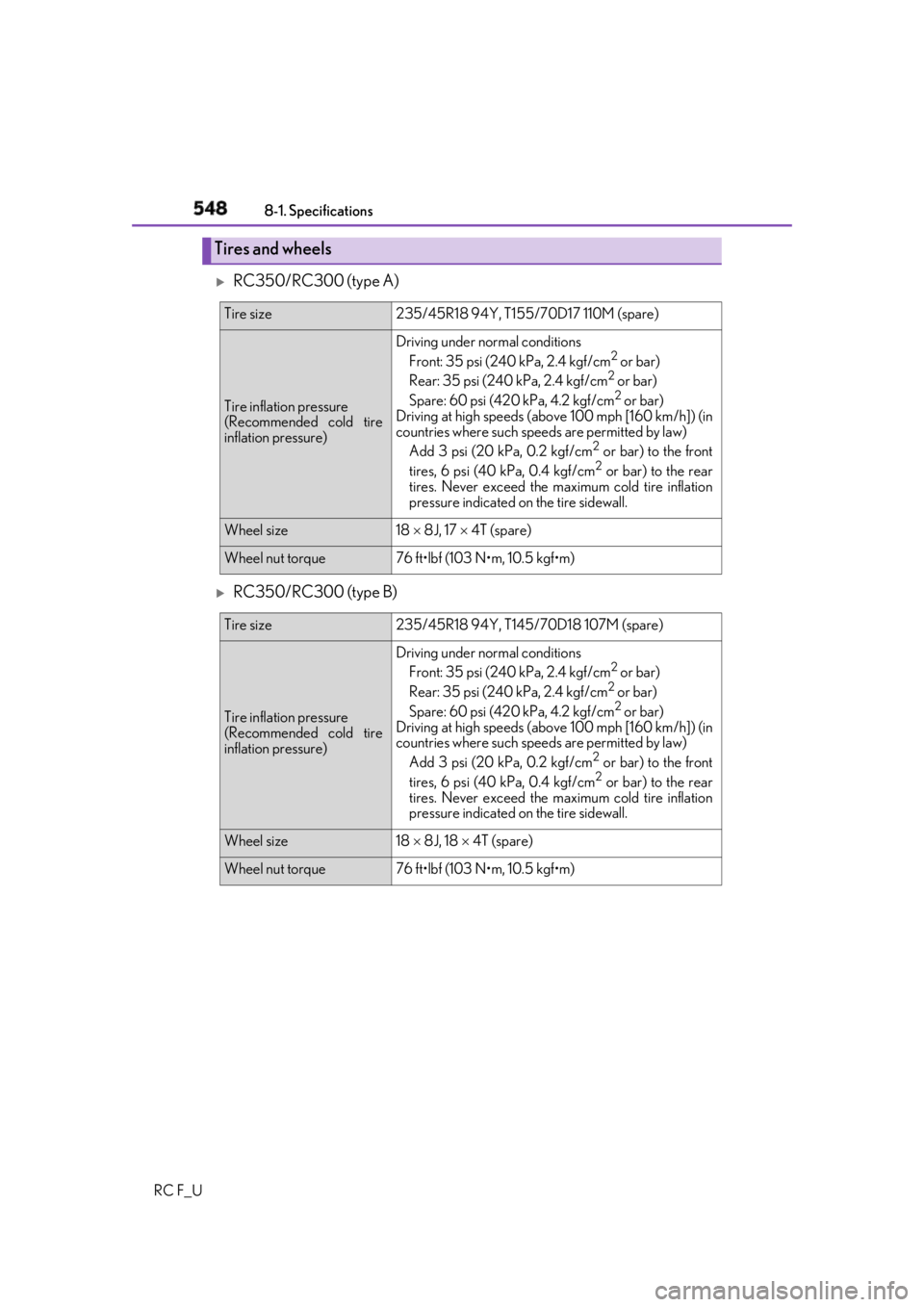2019 LEXUS RCF wheel size
[x] Cancel search: wheel sizePage 416 of 636

416 6-3. Do-it-yourself maintenance
RC F_U ■
Maximum load of tire
Check that the maximum load of the replacement tire is greater than 1/2 of the Gross
Axle Weight Ratings (GAWR) of either the front axle or the rear axle, whichever is
greater.
■
Tire types ●
Summer tires
Summer tires are high-speed performance ti res best suited to highway driving under
dry conditions. Since summer tires do not have the same traction performance as
snow tires, summer tires are inadequate for driving on snow-covered or icy roads. For
driving on snow-covered roads or icy road s, the use of snow tires is recommended.
When installing snow tires, be sure to replace all four tires.●
All season tires
All season tires are designed to provide better traction in snow and to be adequate for
driving in most winter conditions as well as for use year-round. All season tires, how-
ever, do not have adequate traction perfor mance compared with snow tires in heavy
or loose snow. Also, all season tires fall short in acceleration and handling perfor-
mance compared with summer tires in highway driving.●
Snow tires
For driving on snow-covered roads or icy roads, we recommend using snow tires. If
you need snow tires, select ti res of the same size, construction and load capacity as the
originally installed tires. Since your vehicle has radial tires as or iginal equipment, make
sure your snow tires also have radial cons truction. Do not install studded tires without
first checking local regulations for possible restrictions. Snow tires should be installed
on all wheels. ( P. 320)■
If the tread on snow tires wears down below 0.16 in. (4 mm)
The effectiveness of the tire s as snow tires is lost.For the GAWR, see the Ce rtification Label. For
the maximum load of the tire, see the load limit
at maximum cold tire inflation pressure men-
tioned on the sidewall of the tire. ( P. 557)
Page 417 of 636

4176-3. Do-it-yourself maintenance
RC F_U 6
Maintenance and care ■
Situations in which the tire pressure warning system may not operate properly ●
In the following cases, the tire pressure warning system may not operate properly.
• If non-genuine Lexus wheels are used.
• A tire has been replaced with a tire that is not an OE (Original Equipment) tire.
• A tire has been replaced with a tire that is not of the specified size.
• Tire chains etc. are equipped.
• An auxiliary-supported run-flat tire is equipped.
• If a window tint that affects th e radio wave signals is installed.
• If there is a lot of snow or ice on the vehi cle, particularly around the wheels or wheel
housings.
• If the tire inflation pressure is extr emely higher than the specified level.
• If tires not equipped with tire pressure warning valves and tr ansmitters are used.
• If the ID code on the tire pressure warning valves and transmitters is not registered
in the tire pressure warning computer. ●
Performance may be affected in the following situations.
• Near a TV tower, electric power plant, gas station, radio station, large display, air-
port or other facility that generates st rong radio waves or electrical noise
• When carrying a portable radio, cellular phone, cordless phon e or other wireless
communication device
If tire position information is not correctly displayed due to the radio wave conditions,
the display may be corrected by driving and changing the radio wave conditions. ●
When the vehicle is parked, the time taken for the warning to start or go off could be
extended. ●
When tire inflation pressure declines rapidly for example when a tire has burst, the
warning may not function. ■
The initialization operation ●
Make sure to carry out initialization afte r adjusting the tire inflation pressure.
Also, make sure the tires are cold before carryi ng out initialization or tire inflation pres-
sure adjustment. ●
If you have accidentally turned the engine swit ch off during initialization, it is not neces-
sary to press the reset switch again as initialization will re start automatically when the
engine switch has been turned to IG NITION ON mode for the next time.●
If you accidentally press the re set switch when initialization is not necessary, adjust the
tire inflation pressure to the specified leve l when the tires are co ld, and conduct initial-
ization again. ■
When initialization of the tire pressure warning system has failed
Initialization can be completed in a few minutes. However, in the following cases, the set-
tings have not been recorded and the system will not operate properly. If repeated
attempts to record tire inflation pressure settings are unsuccessful, have the vehicle
inspected by your Lexus dealer. ●
When operating the tire pres sure warning reset switch, th e tire pressure warning light
does not blink 3 times. ●
After carrying out the initializat ion procedure, the tire pressu re warning light blinks for 1
minute then stays on after driving for 20 minutes.
Page 423 of 636

4236-3. Do-it-yourself maintenance
RC F_U 6
Maintenance and care When replacing wheels, care should be ta ken to ensure that they are equivalent
to those removed in load capacity, diameter, rim width and inset
* .
Replacement wheels are available at your Lexus dealer.
* : Conventionally referred to as “offset”.
Lexus does not recommend using the following:●
Wheels of different sizes or types ●
Used wheels ●
Bent wheels that have been straightened ●
Use only Lexus wheel nuts and wrenches designed for use with your alumi-
num wheels. ●
When rotating, repairing or changing your tires, check that the wheel nuts are
still tight after driving 1000 miles (1600 km). ●
Be careful not to damage the aluminum wheels when using tire chains. ●
Use only Lexus genuine balance weights or equivalent and a plastic or rubber
hammer when balancing your wheels. ■
When replacing wheels
The wheels of your vehicle are equipped with tire pressure warning valves and transmit-
ters that allow the tire pressure warning system to provide advance warning in the event
of a loss in tire inflation pressure. Whenever wheels are replaced, tire pressure warning
valves and transmitters must be installed. ( P. 413)Wheels If a wheel is bent, cracked or heavily corroded, it should be replaced. Other-
wise, the tire may separate from the wheel or cause a loss of handling control.
Wheel selection
Aluminum wheel precautions
Page 424 of 636

424 6-3. Do-it-yourself maintenance
RC F_U WARNING ■
When replacing wheels ●
Do not use wheels that are a different size from those recommended in the Owner’s
Manual, as this may result in a loss of handling control. ●
Never use an inner tube in a leaking wheel which is designed for a tubeless tire. Doing
so may result in an accident, causing death or serious injury.
NOTICE ■
Replacing tire pressure warn ing valves and transmitters●
Because tire repair or replacement may affe ct the tire pressure warning valves and
transmitters, make sure to have tires serviced by your Lexus dealer or other qualified
service shop. In addition, ma ke sure to purchase your tire pressure warning valves
and transmitters at your Lexus dealer. ●
Ensure that only genuine Lexus wh eels are used on your vehicle.
Tire pressure warning valves and transmitte rs may not work properly with non-genu-
ine wheels.
Page 459 of 636

4597-2. Steps to take in an emergency
RC F_U 7
When trouble arises WARNING ■
Maintenance of the tires
Each tire, including the spare (if provided), should be checked monthly when cold and
inflated to the inflation pressure recomm ended by the vehicle manufacturer on the
vehicle placard or tire inflation pressure label (tire and load information label). (If your
vehicle has tires of a different size than the size indicated on the vehicle placard or tire
inflation pressure label [tire and load in formation label], you should determine the
proper tire inflation pressure for those tires.)
As an added safety feature, your vehicle ha s been equipped with a tire pressure moni-
toring system (TPMS-tire pressure warning system) that illuminates a low tire pressure
telltale (tire pressure warning light) when on e or more of your tires is significantly
under-inflated. Accordingly, when the low ti re pressure telltale (tire pressure warning
light) illuminates, you should st op and check your tires as soon as possible, and inflate
them to the proper pressure. Driving on a si gnificantly under-inflat ed tire causes the
tire to overheat and can lead to tire failure . Under-inflation also reduces fuel efficiency
and tire tread life, and may affect the vehicle’s handling and stopping ability.
Please note that the TPMS (tire pressure wa rning system) is not a substitute for proper
tire maintenance, and it is th e driver’s responsibility to ma intain correct tire pressure,
even if under-inflation has not reached the le vel to trigger illumina tion of the TPMS low
tire pressure telltale (tir e pressure warning light).
Your vehicle has also been equipped with a TPMS (tire pressure warning system) mal-
function indicator to indicate when the system is not operating properly. The TPMS
(tire pressure warning system) malfunction indi cator is combined with the low tire pres-
sure telltale (tire pressure warning light). When the system detects a malfunction, the
telltale will flash for approximately one mi nute and then remain continuously illumi-
nated. This sequence will cont inue upon subsequent vehicl e start-ups as long as the
malfunction exists. When the malfunction in dicator is illuminated, the system may not
be able to detect or signal low tire pressure as intended.
TPMS (tire pressure warning system) malfun ctions may occur for a variety of reasons,
including the installation of replacement or alternate tires or wheels on the vehicle that
prevent the TPMS (tire pressure warning system) from functioning properly. Always
check the TPMS (tire pressure warning system) malfunction telltale after replacing one
or more tires or wheels on your vehicle to ensure that the replacement or alternate
tires and wheels allow the TPMS (tire pressu re warning system) to continue to function
properly.
NOTICE ■
To ensure the tire pressure warning system operates properly
Do not install tires with different specificatio ns or makers, as the tire pressure warning
system may not operate properly.
Page 500 of 636

500 7-2. Steps to take in an emergency
RC F_U Firmly tighten each wheel nut two or
three times in the order shown in the
illustration. Tightening torque:
76 ft•lbf (103 N•m, 10.5 kgf•m)
Stow the flat tire, tire jack and all tools. ■
The spare tire ●
RC350/RC300:
The spare tire is identified by the label “TEMPORARY USE ONLY” on the tire sidewall.●
Use the spare tire temporarily , and only in an emergency.●
Make sure to check the tire inflat ion pressure of the spare tire. ( P. 548)■
When using the spare tire
As the spare tire is not equipped with a tire pressure warning valv e and transmitter, low
inflation pressure of the spare tire will not be indicated by the tire pressure warning sys-
tem. Also, if you replace the spare tire after the tire pressure warn ing light comes on, the
light remains on. ■
When the spare tire is equipped
The vehicle becomes lower when driving with the spare tire compared to when driving
with standard tires. ■
If you have a flat rear tire on a road covered with snow or ice (vehicles with front and
rear tires of the same size except fo r vehicles with LDH and 19-inch tires)
Install the spare tire on one of the front whee ls of the vehicle. Perform the following steps
and fit tire chains to the rear tires:
Replace a front tire with the spare tire.
Replace the flat rear tire with the tire removed from the front of the vehicle.
Fit tire chains to the rear tires. 4
5
1
2
3
Page 512 of 636

512 7-2. Steps to take in an emergency
RC F_U ■
Emergency tire puncture repair kit ●
The sealant has a limited lifespan. The expiry date is marked on the bottle. The sealant
should be replaced before the expiry date. Contact your Lexus dealer for replacement.●
The sealant stored in the emergency tire puncture repair kit can be used only once to
temporarily repair a single tire. If the seal ant has been used and needs to be purchased,
contact your Lexus dealer. The compressor is reusable.●
The sealant can be used when the outside temperature is from -40 F (-40 C) to
140 F (60 C).●
The kit is exclusively designed for size and type of tires originally in stalled on your vehi-
cle. Do not use it for tires that a different size than the original ones, or for any other
purposes. ●
If the sealant gets on yo ur clothes, it may stain.●
If the sealant adheres to a wheel or the surface of the vehicle body, the stain may not be
removable if it is not cleaned at once. Immediately wipe away the sealant with a wet
cloth. ●
During operation of the kit, a loud operation noise is produc ed. This does not indicate a
malfunction. ●
Do not use the emergency tire puncture repair kit to check or to adjust the tire pres-
sure.
Page 548 of 636

548 8-1. Specifications
RC F_U
RC350/RC300 (type A)
RC350/RC300 (type B)Tires and wheels Tire size 235/45R18 94Y, T155/70D17 110M (spare)
Tire inflation pressure
(Recommended cold tire
inflation pressure) Driving under normal conditions
Front: 35 psi (240 kPa, 2.4 kgf/cm 2
or bar)
Rear: 35 psi (240 kPa, 2.4 kgf/cm 2
or bar)
Spare: 60 psi (420 kPa, 4.2 kgf/cm 2
or bar)
Driving at high speeds (above 100 mph [160 km/h]) (in
countries where such speeds are permitted by law)
Add 3 psi (20 kPa, 0.2 kgf/cm 2
or bar) to the front
tires, 6 psi (40 kPa, 0.4 kgf/cm 2
or bar) to the rear
tires. Never exceed the maximum cold tire inflation
pressure indicated on the tire sidewall.
Wheel size 18 8J, 17 4T (spare)
Wheel nut torque 76 ft •
lbf (103 N •
m, 10.5 kgf •
m)
Tire size 235/45R18 94Y, T145/70D18 107M (spare)
Tire inflation pressure
(Recommended cold tire
inflation pressure) Driving under normal conditions
Front: 35 psi (240 kPa, 2.4 kgf/cm 2
or bar)
Rear: 35 psi (240 kPa, 2.4 kgf/cm 2
or bar)
Spare: 60 psi (420 kPa, 4.2 kgf/cm 2
or bar)
Driving at high speeds (above 100 mph [160 km/h]) (in
countries where such speeds are permitted by law)
Add 3 psi (20 kPa, 0.2 kgf/cm 2
or bar) to the front
tires, 6 psi (40 kPa, 0.4 kgf/cm 2
or bar) to the rear
tires. Never exceed the maximum cold tire inflation
pressure indicated on the tire sidewall.
Wheel size 18 8J, 18 4T (spare)
Wheel nut torque 76 ft •
lbf (103 N •
m, 10.5 kgf •
m)